 |
||
|
||
| ||
This article carries nothing new about the chipset; we are going to tell you just what appeared on the market since our last review, what changed and what else the manufacturers were able to squeeze out of this chipset. The excitement around the i845 is over. A wave of angriness of users directed at the Intel's policy let up. The IT community has almost lost its interest to this chipset and now its attention is attracted to the P4X266 and a follower of the i845 - i845-D. There is an old Oriental saying: the dogs bark, but the caravan goes on. This saying excellently describes an Intel's policy concerning the SDRAM chipset for Pentium 4. The key idea in discussions about this chipset is that it is a bathos of stupidity to put the Pentium 4 on the SDRAM. There is a narrow IT circle which understands why the SDRAM limits this processor so strongly, and there is a wide circle of average users who didn't hear either about QPB or DDR RAM or ascending and descending fronts of strobe pulses... So, you may argue and prove as much as you want that a system of a processor designed for RDRAM and of a chipset meant for SDRAM is doomed to death. But what is it going to change? An expert will anyway never buy the i845. And how many, do you think, there are average users who would listen to all arguments, understand and refuse to get this chipset in favor of an alternative one? Right, their percentage is so small that we can neglect it. It is like in the field of home equipment. Do you often account for a performance index of an electric kettle when you are going to buy it? The most of users do not stuff their heads with unnecessary technical details. If the best friend says that Intel is good, VIA&AMD is no good, and Pentium 4 is a dream, then it is true :) Besides, there are plenty of Intel's fans who do not care whether it is good or bad, fast or slow. That is why the i845 is in demand, and the sales will grow up until Intel won't need it. But is it really so bad? For a home/office user the performance of the Pentium 4 1.4 - 2 GHz is more than enough, even if it comes with SDRAM. Sure, it is possible to get a higher performance at the same or smaller sum of money, but not everybody understands it. That is why, whatever experts may say, Intel has once again reached it goal. Test system:
Software:
Comparison characteristics of the mainboards
ASUS P4B-LXWe have already examined this board earlier that is why our attentive readers can omit several paragraphs below. 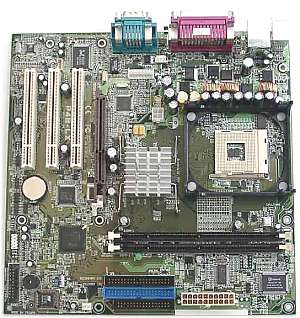 The board features a great deal of integrated functions, and the most interesting is that all this is housed in a mATX board. The board we tested is a preproduction sample, despite its version 1.04. The company spent a lot of time to eliminate all possible bugs. And as a result, everything worked flawlessly in our tests. The board comes only with a disc with drivers. It has a new shell for installation of its programs and drivers. There are such utilities as Winbond Voice Edit (for recording wav-files in EEPROM for realization of the POST Reporter technology (it notifies about booting problems)), Logo (for creation of different screensavers), AsusUpdate and AsusHotkey. Of course, there is also a utility for monitoring fan speeds and temperatures - Asus PCProbe, and freeware programs such as Adobe Acrobat Reader, PC-Cillin 2000 v. 7.0 from Trend Micro, Power Player SE 5.0, VideoLive Mail 4.0 from CyberLink and 3Deep for adjusting color balance. The board incorporates a network controller, a IEEE1394 (FireWire) bus controller and the most advanced AC'97 codec from Avance Logic which allows connecting other devices in the digital mode - on the P4B board there was a bracket for the rear computer panel with a TosLink optical-out. Here the engineers soldered this output right to the board. On the whole, the rear panel looks unusual: the FireWire and optical TosLink connectors have replaced serial ports' ones, and the GamePort connector is replaced with a single serial port.  The GamePort is absent, and I understand why. There are not many modern wheels and joysticks with such connectors, they are mainly connected via a USB bus. The layout is quite convenient for the mATX format. Unfortunately, a connector for a power button, LEDs etc. was redesigned, though it looks the same. The stable core power supply is maintained by 11 capacitors - 8 of 1500uF and 3 of 2500uF. There is only one switch - for clearing the CMOS and several unsoldered ones. The BIOS is based on the v. Medallion from Award and contains a heap of various settings. Here you can adjust modes of memory and an AGP bus. You can also change a FSB frequency (100, 103, 105, 107, 109, 111, 114, 117, 120, 127, 130 and 133MHz), a CPU multiplier, a correlation of the memory and FSB frequencies (1:1 or 3:4), manually distribute interrupts among PCI slots etc. On the whole the board looks great, but I wonder who it is meant for? A home user? Then why it is equipped with a FireWire controller (there are not much nonprofessional devices with such an interface and they cost a fortune). For a video editing station? But the board is of the mATX format... DFI NB72-SRWe have already examined this board earlier that is why our attentive readers can omit several paragraphs below. 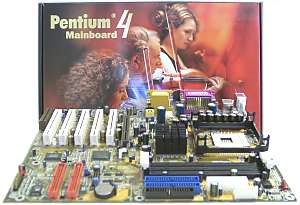 A standard box contains the board, a user's manual in English, French, German and Spanish, an installation manual for the IDE RAID, a diskette with drivers, ATA66/100 cables, an FDD one and a CD. The latter comes with drivers, a user's manual in .pdf, Adobe Acrobat Reader, Winbond Hardware Doctor and PCCillin 2000.  The soldering is of high quality, but there are some tiny drawbacks in the layout, for example, IDE Raid connectors are located behind the PCI slots - if full-sized expansion cards are inserted it is difficult to handle cables for these connectors. The board features 15 capacitors of 2200uF. There are several switches: one is for clearing the CMOS, two can help you start up the system with the PS/2 & USB devices; and the last one sets the basic FSB frequency - Auto, 100 or 133 MHz. The BIOS is based on the v.6.0 from Award and offers a wide range of settings for memory timings and an AGP bus, manual distribution of interrupts among PCI slots, unimpressive changeable multiplier and FSB frequency (in 1 MHz steps). It is a stable board which suits for a great deal of tasks - it is a bit cheaper than its competitors but has an excellent operating speed and plenty various functions. AOpen AX4BS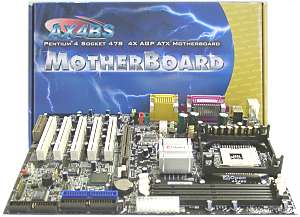 Products from this company usually work stably, have good speed characteristics and an excellent design. This time we have a board on black textolite with a silvery heatsink. 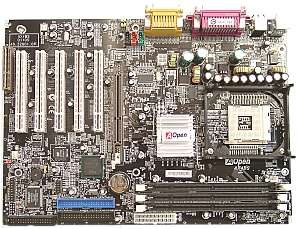 On the contrary, the box the board comes in is florid. It contains ATA66/100, 40-conductor IDE and FDD cables, a card for registration in the company's club, a poster with key settings and a CD. As you can see, there is no a normal user's manual, though the CD has its e-version in .pdf. Besides, the CD contains drivers and several free programs such as Adobe Acrobat Reader and DocuReader (for .pdf files), Norton CrashGuard, Norton Antivirus 5.0, E-Color with E-Deep for adjusting a color balance, and some other utilities. The quality of the board is quite good. But as it's narrow IDE and FDD connectors are located behind PCI slots, and a power supply connector is too close to memory modules' ones. Those were downsides, but there are also some advantages: to reduce a probability of damage of the PCB (as you know, heatsinks for Intel Pentium 4 weighs almost 0.5 kg) the cooler's mount is screwed to a massive plate behind (instead being attached to the board). The AGP slot has a clamp. There is also a connector for audio-outs from the front computer panel. Several connectors are unsoldered. There are 15 Low ESR capacitors - 12 of 1500 and 3 of 2200uF. A switch is only one and it allows clearing the CMOS. The BIOS is based on v6.00PG from Award. It offers a great deal of settings for memory, and AGP and PCI buses. You can also change Vcore and a FSB frequency in 1 MHz steps from 100 to 248! MHz. This board is not an overclocker's dream but it will be a good purchase for home and office computers. Abit BW7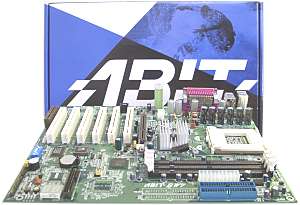 This board from Abit is designed for Intel Pentium 4 processors meant for Socket 423. And this is probably the only difference from the BL7 board. We have already written about BL7 and BL7-Raid boards which are based on this chipset as well. They differ only in a presence of an external IDE Raid controller and in a socket type. This time we have a production sample, and a box of a new interesting design contains ATA66/100 and FDD cables, a bracket with a Game-port, a bracket for the rear computer panel, a diskette with drivers for the IDE Raid and a CD with board's drivers. The CD contains a standard set of Abit's programs: a DVD player - WinDVD, Hardware Doctor, Adobe Acrobat Reader and Buzzsoft's programs - SoftCardManager, SoftCopier, SoftPostCard, SoftBulkEmail and a utility for a low-level formatting of hard discs from Award. 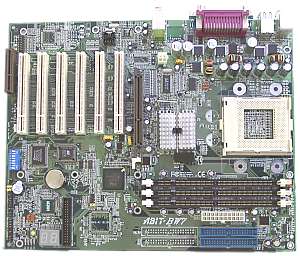 The layout is quite convenient. The only disadvantage is a position of audio-ins. The board carries the Abit Engineered technology. Therefore, it has two 7-segment LEDs (so that we know how loading proceeds), power and reset buttons onboard and overclocking stripes. But the latter are, for some reason, absent. Besides, there are 6 3300uF and 4 1200uF capacitors to make the board more stable in an overclocking mode. There is also an unsoldered place for a chip and tracks coming from it to unsoldered connectors marked as USB_AB1 and USB_CD1. The space for the IDE Raid is also provided. The switches will help you change processor modes, clear the CMOS etc. The BIOS is based on the v6.00PG from Award and features the SoftMenu technology to overclock the processor. Here you can change a memory frequency in 1 MHz steps (from 100 to 250MHz), change a FSB speed, change a CPU multiplier and Vcore. You can also alter a correlation of FSB, PCI and memory frequencies. Besides, you may adjust the AGP bus and distribute interrupts among PCI slots. Such a high overclocking potential of the board doesn't prevent it from working stably at rated and higher frequencies. Test results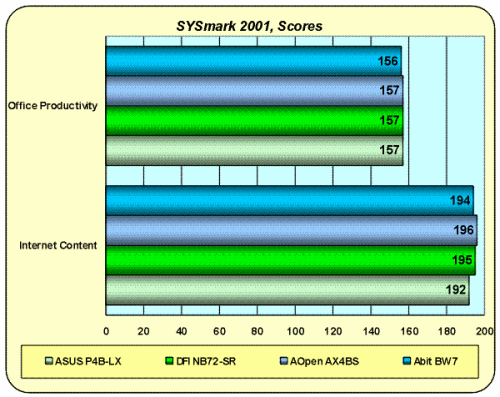 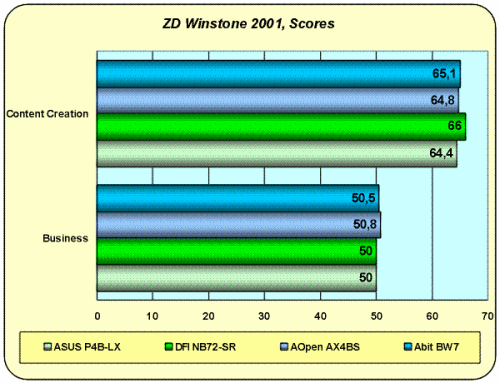 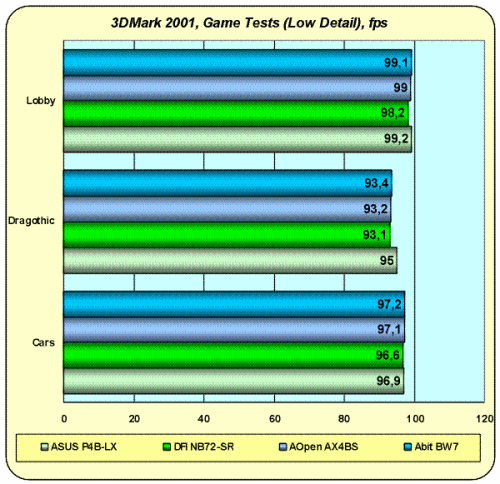 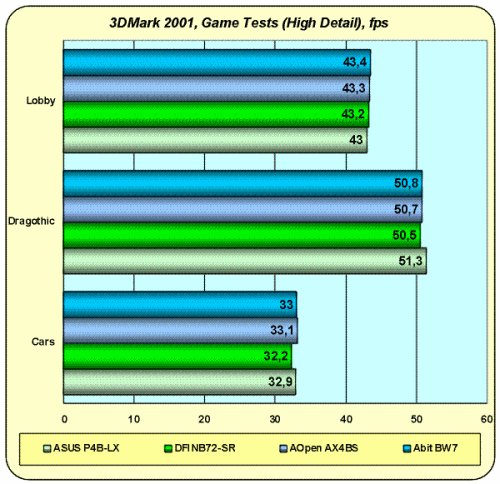 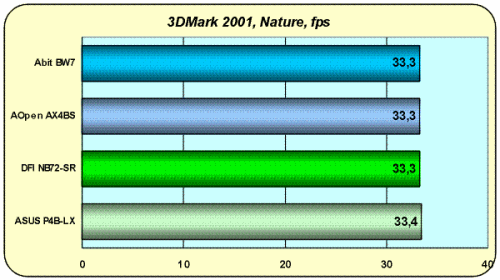 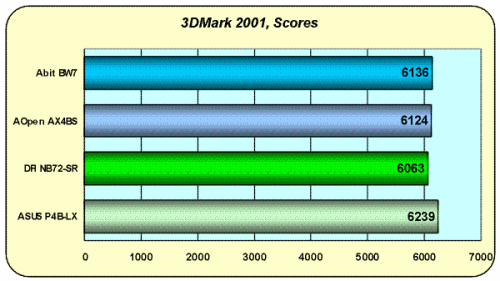 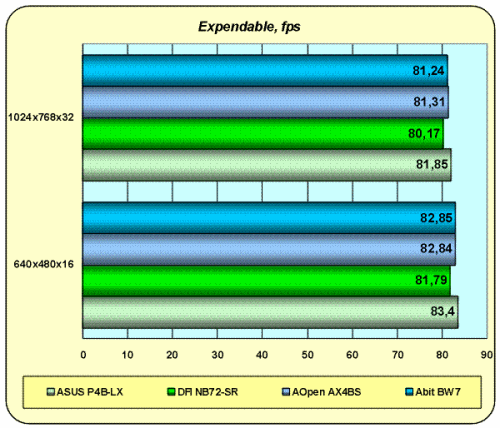 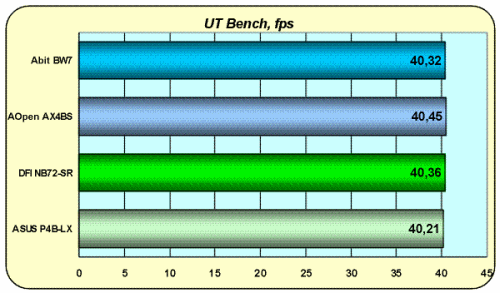 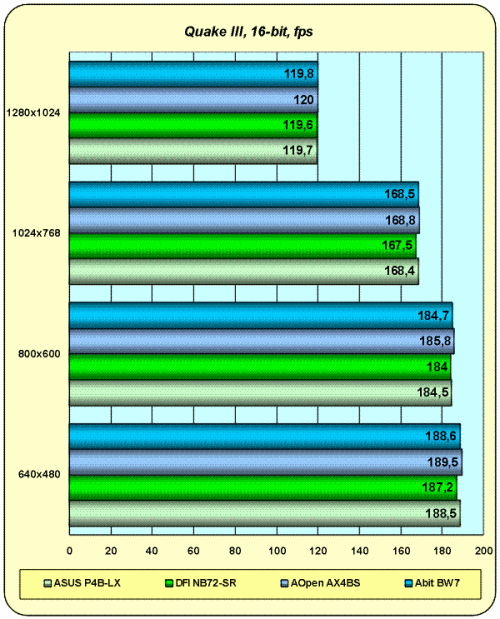 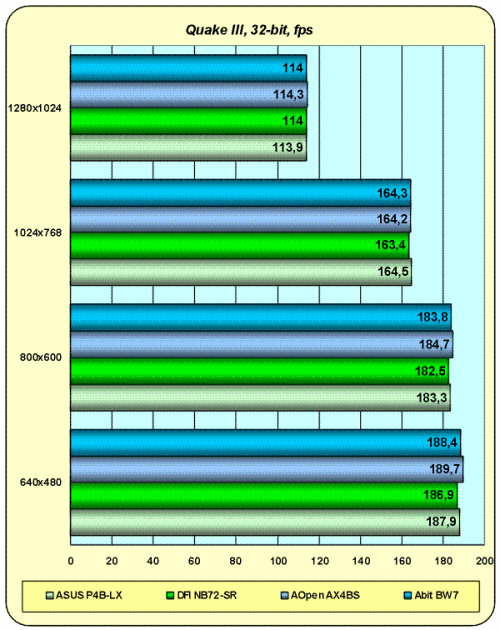 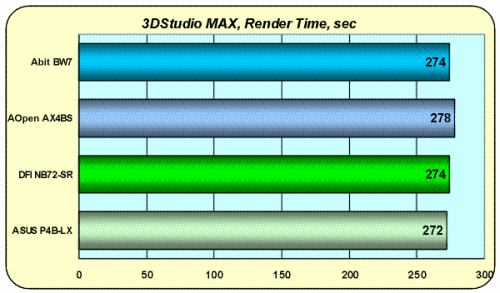 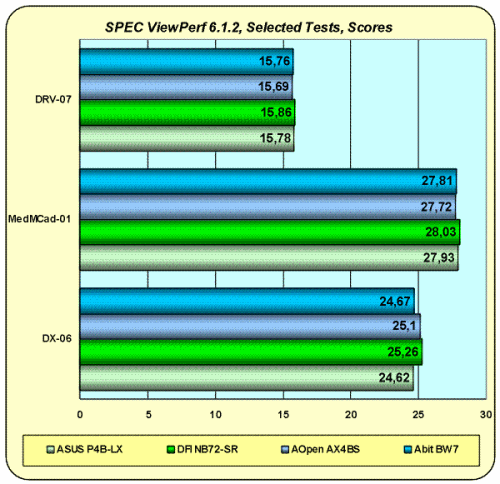 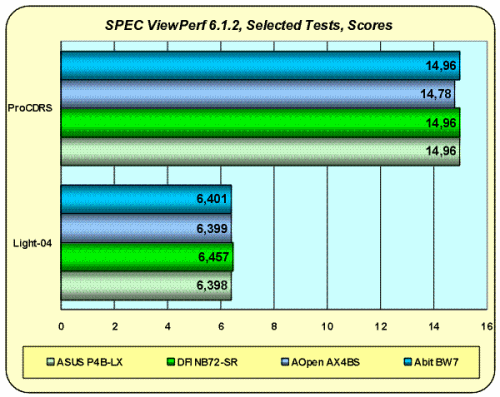 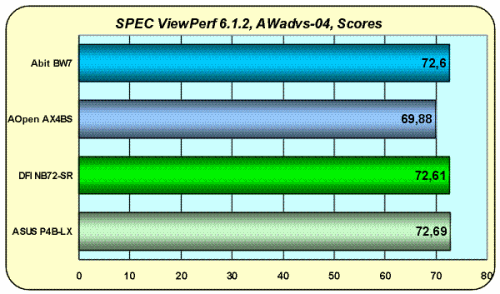 It makes no sense to comment each diagram. All the boards show an equal performance level. The difference between them shouldn't be taken into account as it is just an inaccuracy of measurements. Only in the 3Dstudio MAX the AOpen's board comes a bit ahead, and in the general 3DMark 2001 test the ASUS nudges out the others. Some discrepancy between the today's tests and the last one of 12 boards can be explained by usage of a newer version of the Detonators. ConclusionAs expected, no revolutionary changes were made.
The new products have almost the same performance. There is nothing
more to tweak. Everything that could be done is done.
Write a comment below. No registration needed!
|
Platform · Video · Multimedia · Mobile · Other || About us & Privacy policy · Twitter · Facebook Copyright © Byrds Research & Publishing, Ltd., 1997–2011. All rights reserved. | ||||||||||||||||||||||||||||||||||||||||||||||||||||||||||||||||||||||||||||||||||||||||||||||||||||||||||||||